Public Health Intervention: Partnership in HIV Prevention Strategies
VerifiedAdded on 2023/06/08
|11
|4051
|500
Report
AI Summary
This report provides a detailed analysis of public health interventions aimed at HIV prevention, emphasizing the collaborative role of primary care. It discusses four key interventions working in partnership with primary care, focusing on their concepts and principles. The report also explores evidence-based interventions and their benefits to the community, along with strategies to redesign interventions for improved quality and outcomes. Furthermore, it identifies various methods for evaluating public health interventions and determines the most appropriate approach for assessing HIV prevention programs. The discussion covers the importance of sexual health education, awareness campaigns, and targeted interventions for high-risk groups, highlighting the role of general practitioners in addressing myths and promoting responsible sexual behavior. The report concludes by underscoring the significance of these interventions in reducing HIV transmission rates and improving public health outcomes. Desklib provides access to similar solved assignments and past papers for students.
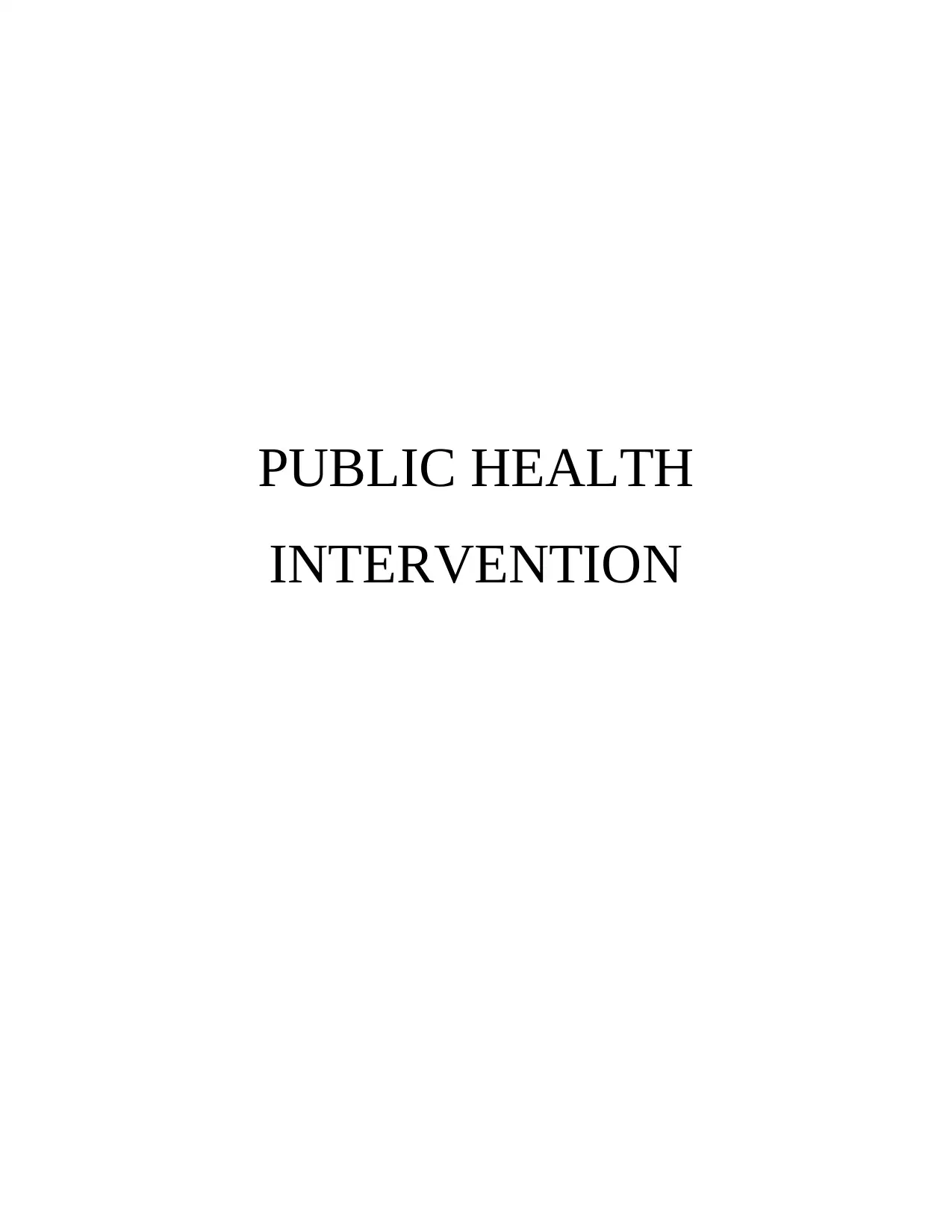
PUBLIC HEALTH
INTERVENTION
INTERVENTION
Paraphrase This Document
Need a fresh take? Get an instant paraphrase of this document with our AI Paraphraser
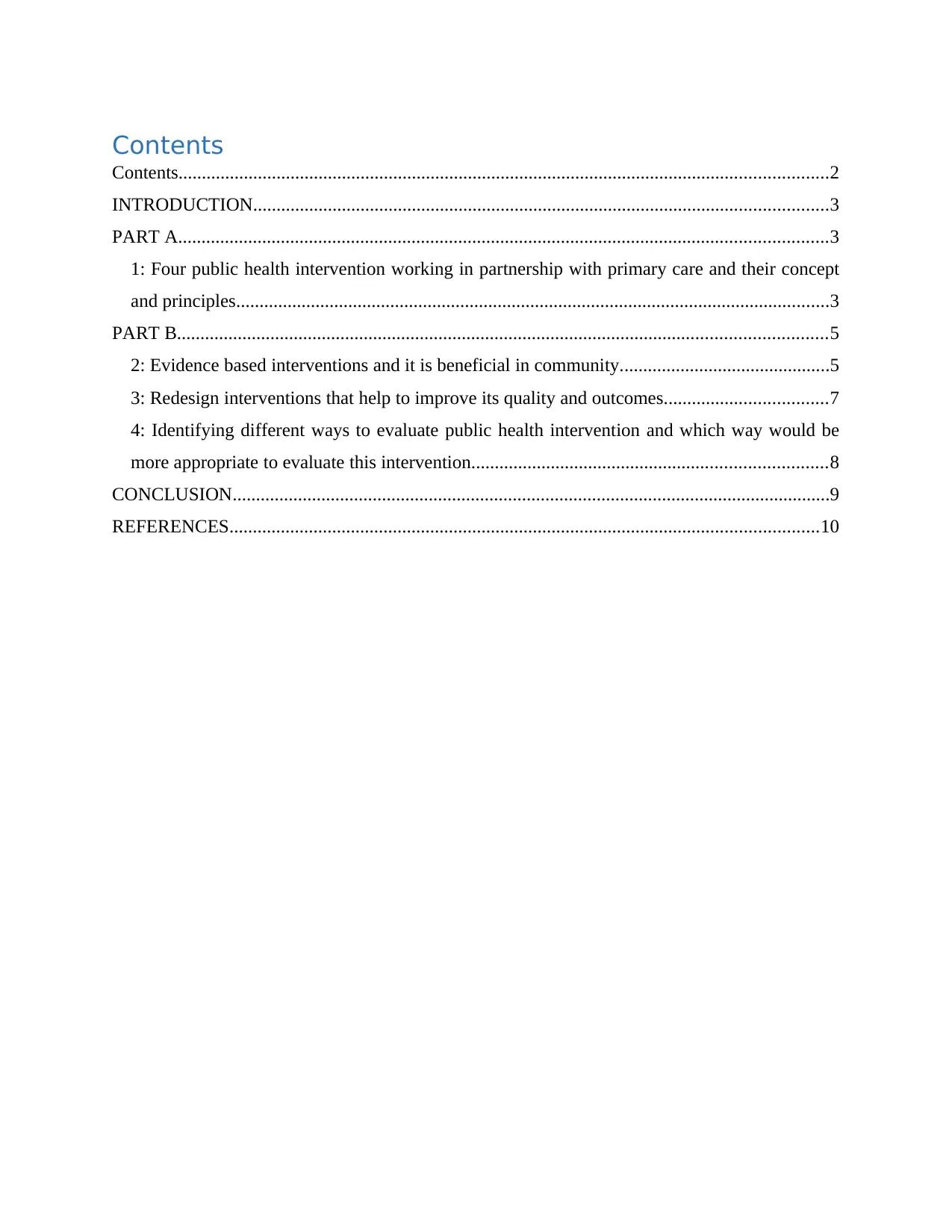
Contents
Contents...........................................................................................................................................2
INTRODUCTION...........................................................................................................................3
PART A...........................................................................................................................................3
1: Four public health intervention working in partnership with primary care and their concept
and principles...............................................................................................................................3
PART B...........................................................................................................................................5
2: Evidence based interventions and it is beneficial in community.............................................5
3: Redesign interventions that help to improve its quality and outcomes...................................7
4: Identifying different ways to evaluate public health intervention and which way would be
more appropriate to evaluate this intervention............................................................................8
CONCLUSION................................................................................................................................9
REFERENCES..............................................................................................................................10
Contents...........................................................................................................................................2
INTRODUCTION...........................................................................................................................3
PART A...........................................................................................................................................3
1: Four public health intervention working in partnership with primary care and their concept
and principles...............................................................................................................................3
PART B...........................................................................................................................................5
2: Evidence based interventions and it is beneficial in community.............................................5
3: Redesign interventions that help to improve its quality and outcomes...................................7
4: Identifying different ways to evaluate public health intervention and which way would be
more appropriate to evaluate this intervention............................................................................8
CONCLUSION................................................................................................................................9
REFERENCES..............................................................................................................................10
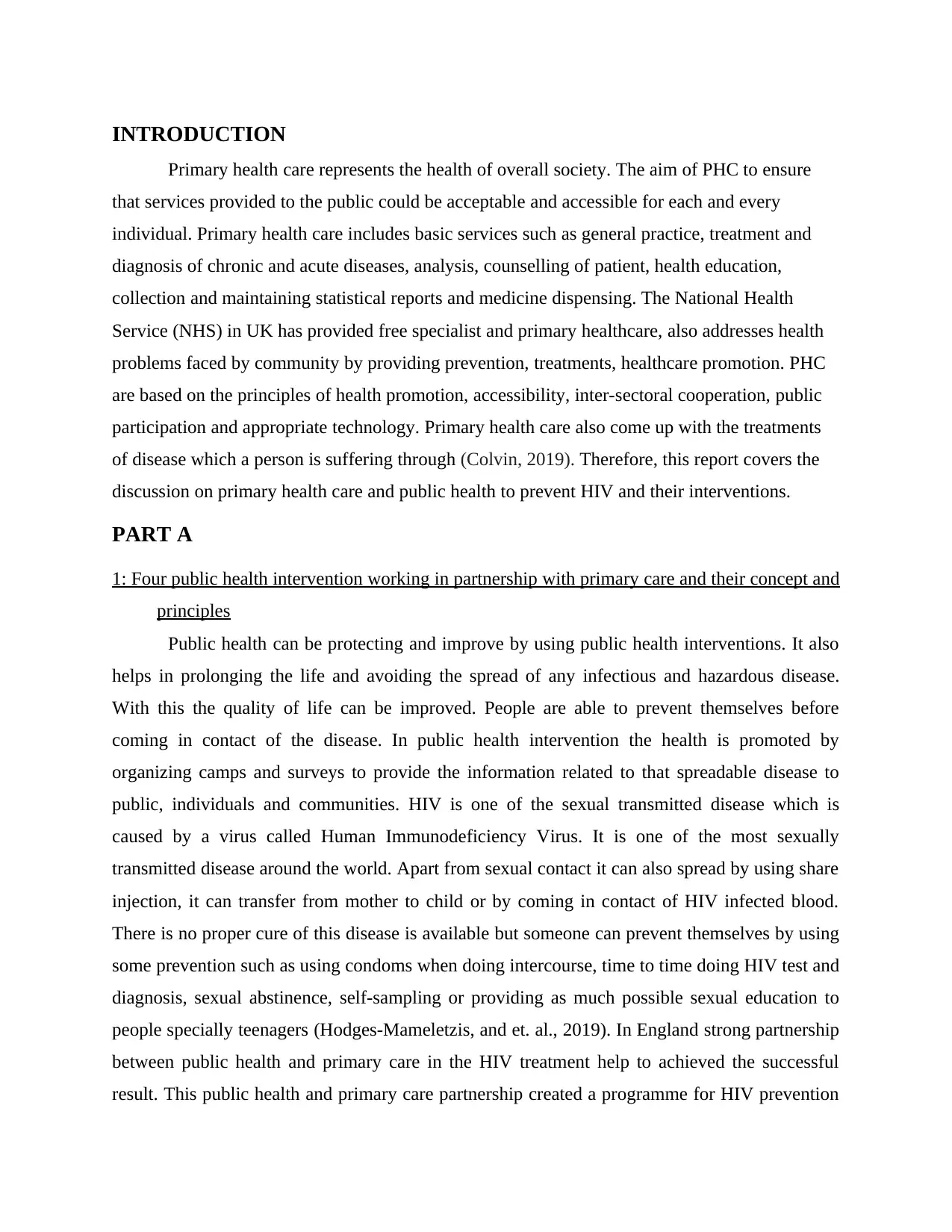
INTRODUCTION
Primary health care represents the health of overall society. The aim of PHC to ensure
that services provided to the public could be acceptable and accessible for each and every
individual. Primary health care includes basic services such as general practice, treatment and
diagnosis of chronic and acute diseases, analysis, counselling of patient, health education,
collection and maintaining statistical reports and medicine dispensing. The National Health
Service (NHS) in UK has provided free specialist and primary healthcare, also addresses health
problems faced by community by providing prevention, treatments, healthcare promotion. PHC
are based on the principles of health promotion, accessibility, inter-sectoral cooperation, public
participation and appropriate technology. Primary health care also come up with the treatments
of disease which a person is suffering through (Colvin, 2019). Therefore, this report covers the
discussion on primary health care and public health to prevent HIV and their interventions.
PART A
1: Four public health intervention working in partnership with primary care and their concept and
principles
Public health can be protecting and improve by using public health interventions. It also
helps in prolonging the life and avoiding the spread of any infectious and hazardous disease.
With this the quality of life can be improved. People are able to prevent themselves before
coming in contact of the disease. In public health intervention the health is promoted by
organizing camps and surveys to provide the information related to that spreadable disease to
public, individuals and communities. HIV is one of the sexual transmitted disease which is
caused by a virus called Human Immunodeficiency Virus. It is one of the most sexually
transmitted disease around the world. Apart from sexual contact it can also spread by using share
injection, it can transfer from mother to child or by coming in contact of HIV infected blood.
There is no proper cure of this disease is available but someone can prevent themselves by using
some prevention such as using condoms when doing intercourse, time to time doing HIV test and
diagnosis, sexual abstinence, self-sampling or providing as much possible sexual education to
people specially teenagers (Hodges-Mameletzis, and et. al., 2019). In England strong partnership
between public health and primary care in the HIV treatment help to achieved the successful
result. This public health and primary care partnership created a programme for HIV prevention
Primary health care represents the health of overall society. The aim of PHC to ensure
that services provided to the public could be acceptable and accessible for each and every
individual. Primary health care includes basic services such as general practice, treatment and
diagnosis of chronic and acute diseases, analysis, counselling of patient, health education,
collection and maintaining statistical reports and medicine dispensing. The National Health
Service (NHS) in UK has provided free specialist and primary healthcare, also addresses health
problems faced by community by providing prevention, treatments, healthcare promotion. PHC
are based on the principles of health promotion, accessibility, inter-sectoral cooperation, public
participation and appropriate technology. Primary health care also come up with the treatments
of disease which a person is suffering through (Colvin, 2019). Therefore, this report covers the
discussion on primary health care and public health to prevent HIV and their interventions.
PART A
1: Four public health intervention working in partnership with primary care and their concept and
principles
Public health can be protecting and improve by using public health interventions. It also
helps in prolonging the life and avoiding the spread of any infectious and hazardous disease.
With this the quality of life can be improved. People are able to prevent themselves before
coming in contact of the disease. In public health intervention the health is promoted by
organizing camps and surveys to provide the information related to that spreadable disease to
public, individuals and communities. HIV is one of the sexual transmitted disease which is
caused by a virus called Human Immunodeficiency Virus. It is one of the most sexually
transmitted disease around the world. Apart from sexual contact it can also spread by using share
injection, it can transfer from mother to child or by coming in contact of HIV infected blood.
There is no proper cure of this disease is available but someone can prevent themselves by using
some prevention such as using condoms when doing intercourse, time to time doing HIV test and
diagnosis, sexual abstinence, self-sampling or providing as much possible sexual education to
people specially teenagers (Hodges-Mameletzis, and et. al., 2019). In England strong partnership
between public health and primary care in the HIV treatment help to achieved the successful
result. This public health and primary care partnership created a programme for HIV prevention
⊘ This is a preview!⊘
Do you want full access?
Subscribe today to unlock all pages.

Trusted by 1+ million students worldwide
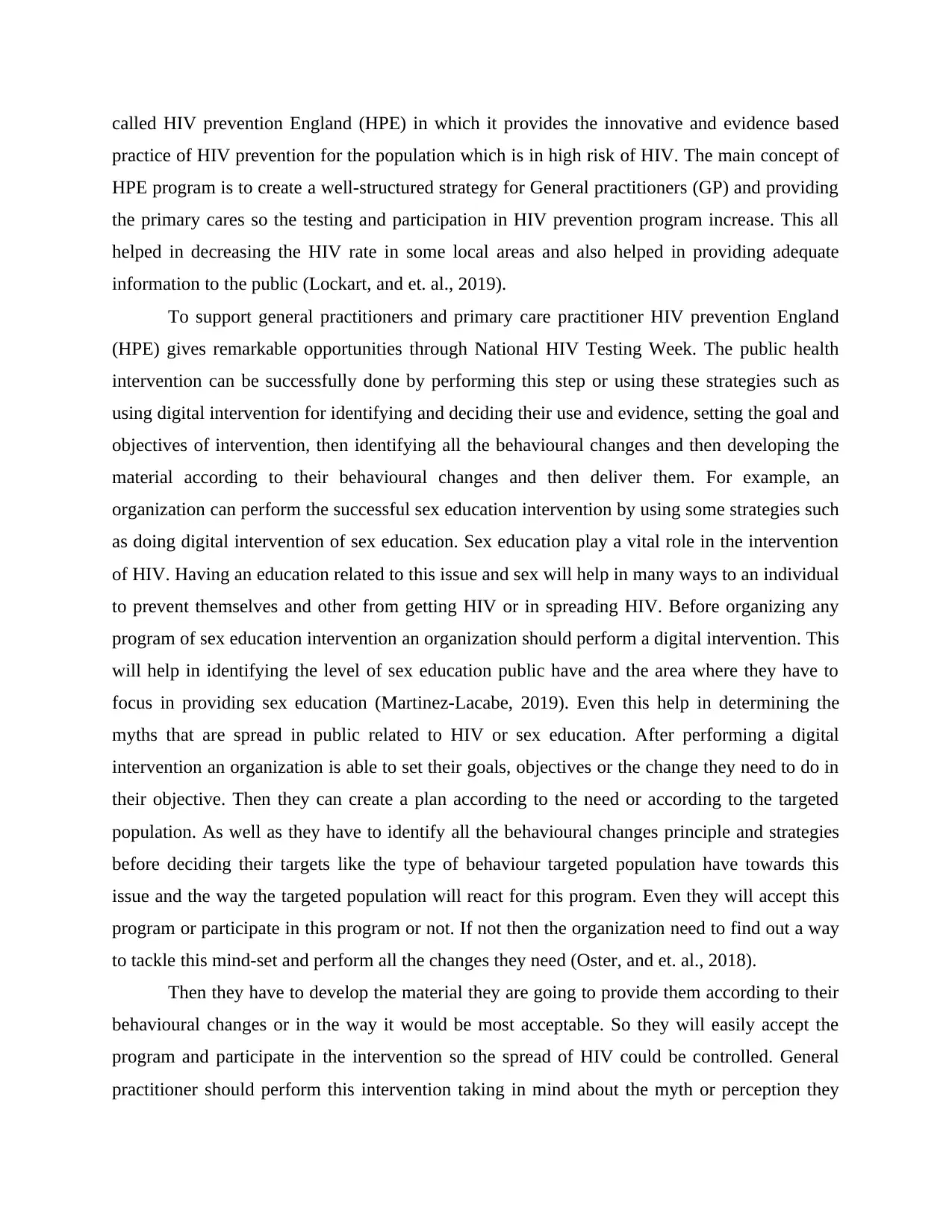
called HIV prevention England (HPE) in which it provides the innovative and evidence based
practice of HIV prevention for the population which is in high risk of HIV. The main concept of
HPE program is to create a well-structured strategy for General practitioners (GP) and providing
the primary cares so the testing and participation in HIV prevention program increase. This all
helped in decreasing the HIV rate in some local areas and also helped in providing adequate
information to the public (Lockart, and et. al., 2019).
To support general practitioners and primary care practitioner HIV prevention England
(HPE) gives remarkable opportunities through National HIV Testing Week. The public health
intervention can be successfully done by performing this step or using these strategies such as
using digital intervention for identifying and deciding their use and evidence, setting the goal and
objectives of intervention, then identifying all the behavioural changes and then developing the
material according to their behavioural changes and then deliver them. For example, an
organization can perform the successful sex education intervention by using some strategies such
as doing digital intervention of sex education. Sex education play a vital role in the intervention
of HIV. Having an education related to this issue and sex will help in many ways to an individual
to prevent themselves and other from getting HIV or in spreading HIV. Before organizing any
program of sex education intervention an organization should perform a digital intervention. This
will help in identifying the level of sex education public have and the area where they have to
focus in providing sex education (Martinez-Lacabe, 2019). Even this help in determining the
myths that are spread in public related to HIV or sex education. After performing a digital
intervention an organization is able to set their goals, objectives or the change they need to do in
their objective. Then they can create a plan according to the need or according to the targeted
population. As well as they have to identify all the behavioural changes principle and strategies
before deciding their targets like the type of behaviour targeted population have towards this
issue and the way the targeted population will react for this program. Even they will accept this
program or participate in this program or not. If not then the organization need to find out a way
to tackle this mind-set and perform all the changes they need (Oster, and et. al., 2018).
Then they have to develop the material they are going to provide them according to their
behavioural changes or in the way it would be most acceptable. So they will easily accept the
program and participate in the intervention so the spread of HIV could be controlled. General
practitioner should perform this intervention taking in mind about the myth or perception they
practice of HIV prevention for the population which is in high risk of HIV. The main concept of
HPE program is to create a well-structured strategy for General practitioners (GP) and providing
the primary cares so the testing and participation in HIV prevention program increase. This all
helped in decreasing the HIV rate in some local areas and also helped in providing adequate
information to the public (Lockart, and et. al., 2019).
To support general practitioners and primary care practitioner HIV prevention England
(HPE) gives remarkable opportunities through National HIV Testing Week. The public health
intervention can be successfully done by performing this step or using these strategies such as
using digital intervention for identifying and deciding their use and evidence, setting the goal and
objectives of intervention, then identifying all the behavioural changes and then developing the
material according to their behavioural changes and then deliver them. For example, an
organization can perform the successful sex education intervention by using some strategies such
as doing digital intervention of sex education. Sex education play a vital role in the intervention
of HIV. Having an education related to this issue and sex will help in many ways to an individual
to prevent themselves and other from getting HIV or in spreading HIV. Before organizing any
program of sex education intervention an organization should perform a digital intervention. This
will help in identifying the level of sex education public have and the area where they have to
focus in providing sex education (Martinez-Lacabe, 2019). Even this help in determining the
myths that are spread in public related to HIV or sex education. After performing a digital
intervention an organization is able to set their goals, objectives or the change they need to do in
their objective. Then they can create a plan according to the need or according to the targeted
population. As well as they have to identify all the behavioural changes principle and strategies
before deciding their targets like the type of behaviour targeted population have towards this
issue and the way the targeted population will react for this program. Even they will accept this
program or participate in this program or not. If not then the organization need to find out a way
to tackle this mind-set and perform all the changes they need (Oster, and et. al., 2018).
Then they have to develop the material they are going to provide them according to their
behavioural changes or in the way it would be most acceptable. So they will easily accept the
program and participate in the intervention so the spread of HIV could be controlled. General
practitioner should perform this intervention taking in mind about the myth or perception they
Paraphrase This Document
Need a fresh take? Get an instant paraphrase of this document with our AI Paraphraser
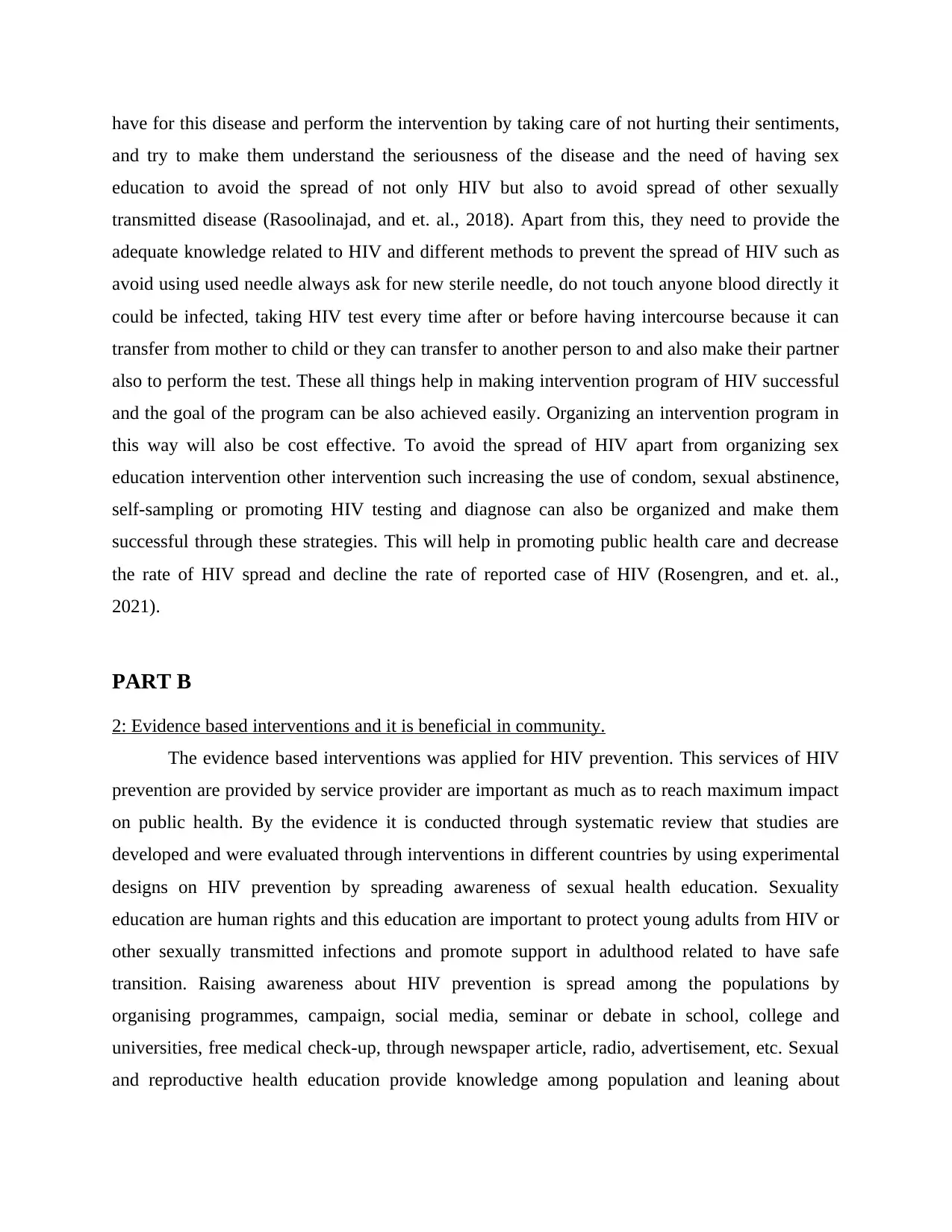
have for this disease and perform the intervention by taking care of not hurting their sentiments,
and try to make them understand the seriousness of the disease and the need of having sex
education to avoid the spread of not only HIV but also to avoid spread of other sexually
transmitted disease (Rasoolinajad, and et. al., 2018). Apart from this, they need to provide the
adequate knowledge related to HIV and different methods to prevent the spread of HIV such as
avoid using used needle always ask for new sterile needle, do not touch anyone blood directly it
could be infected, taking HIV test every time after or before having intercourse because it can
transfer from mother to child or they can transfer to another person to and also make their partner
also to perform the test. These all things help in making intervention program of HIV successful
and the goal of the program can be also achieved easily. Organizing an intervention program in
this way will also be cost effective. To avoid the spread of HIV apart from organizing sex
education intervention other intervention such increasing the use of condom, sexual abstinence,
self-sampling or promoting HIV testing and diagnose can also be organized and make them
successful through these strategies. This will help in promoting public health care and decrease
the rate of HIV spread and decline the rate of reported case of HIV (Rosengren, and et. al.,
2021).
PART B
2: Evidence based interventions and it is beneficial in community.
The evidence based interventions was applied for HIV prevention. This services of HIV
prevention are provided by service provider are important as much as to reach maximum impact
on public health. By the evidence it is conducted through systematic review that studies are
developed and were evaluated through interventions in different countries by using experimental
designs on HIV prevention by spreading awareness of sexual health education. Sexuality
education are human rights and this education are important to protect young adults from HIV or
other sexually transmitted infections and promote support in adulthood related to have safe
transition. Raising awareness about HIV prevention is spread among the populations by
organising programmes, campaign, social media, seminar or debate in school, college and
universities, free medical check-up, through newspaper article, radio, advertisement, etc. Sexual
and reproductive health education provide knowledge among population and leaning about
and try to make them understand the seriousness of the disease and the need of having sex
education to avoid the spread of not only HIV but also to avoid spread of other sexually
transmitted disease (Rasoolinajad, and et. al., 2018). Apart from this, they need to provide the
adequate knowledge related to HIV and different methods to prevent the spread of HIV such as
avoid using used needle always ask for new sterile needle, do not touch anyone blood directly it
could be infected, taking HIV test every time after or before having intercourse because it can
transfer from mother to child or they can transfer to another person to and also make their partner
also to perform the test. These all things help in making intervention program of HIV successful
and the goal of the program can be also achieved easily. Organizing an intervention program in
this way will also be cost effective. To avoid the spread of HIV apart from organizing sex
education intervention other intervention such increasing the use of condom, sexual abstinence,
self-sampling or promoting HIV testing and diagnose can also be organized and make them
successful through these strategies. This will help in promoting public health care and decrease
the rate of HIV spread and decline the rate of reported case of HIV (Rosengren, and et. al.,
2021).
PART B
2: Evidence based interventions and it is beneficial in community.
The evidence based interventions was applied for HIV prevention. This services of HIV
prevention are provided by service provider are important as much as to reach maximum impact
on public health. By the evidence it is conducted through systematic review that studies are
developed and were evaluated through interventions in different countries by using experimental
designs on HIV prevention by spreading awareness of sexual health education. Sexuality
education are human rights and this education are important to protect young adults from HIV or
other sexually transmitted infections and promote support in adulthood related to have safe
transition. Raising awareness about HIV prevention is spread among the populations by
organising programmes, campaign, social media, seminar or debate in school, college and
universities, free medical check-up, through newspaper article, radio, advertisement, etc. Sexual
and reproductive health education provide knowledge among population and leaning about
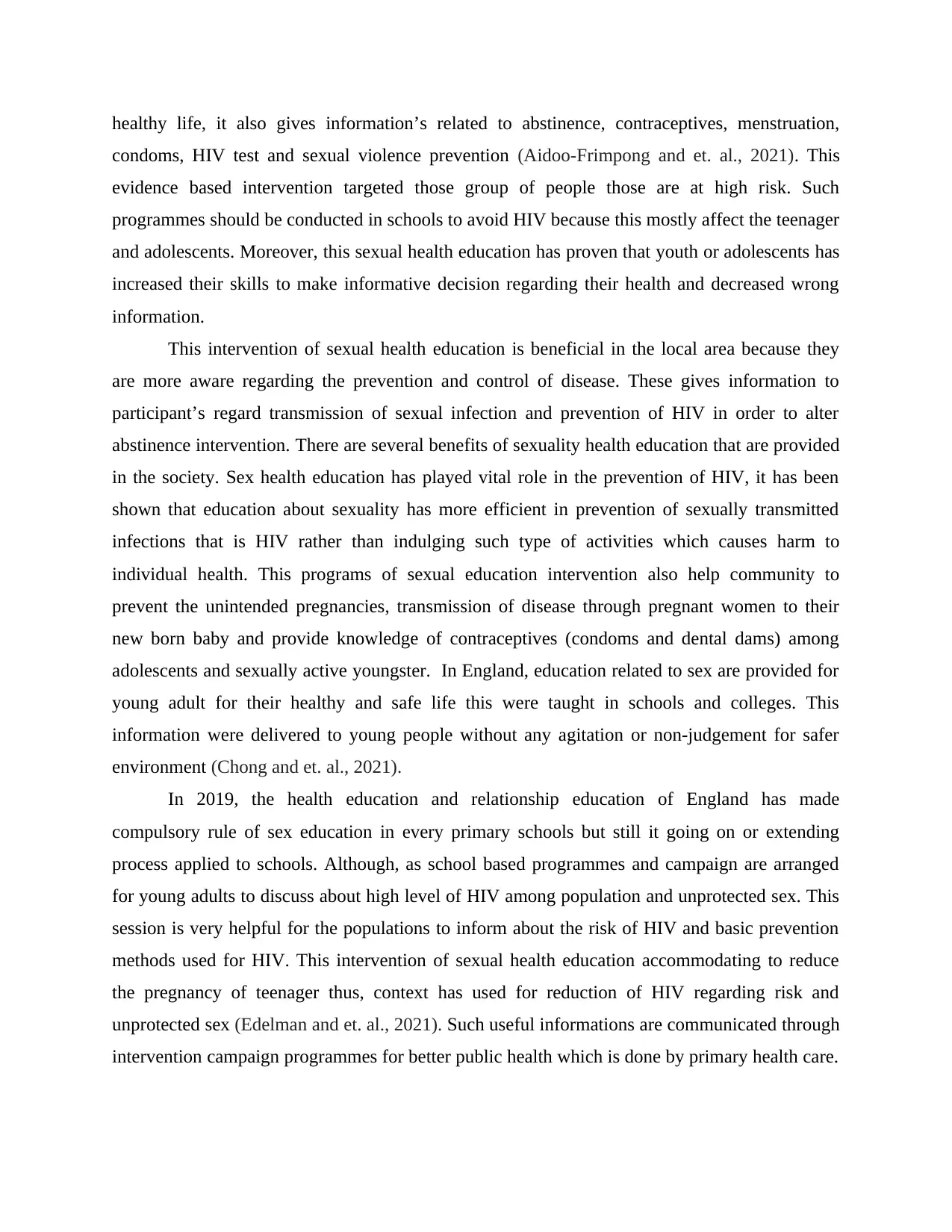
healthy life, it also gives information’s related to abstinence, contraceptives, menstruation,
condoms, HIV test and sexual violence prevention (Aidoo-Frimpong and et. al., 2021). This
evidence based intervention targeted those group of people those are at high risk. Such
programmes should be conducted in schools to avoid HIV because this mostly affect the teenager
and adolescents. Moreover, this sexual health education has proven that youth or adolescents has
increased their skills to make informative decision regarding their health and decreased wrong
information.
This intervention of sexual health education is beneficial in the local area because they
are more aware regarding the prevention and control of disease. These gives information to
participant’s regard transmission of sexual infection and prevention of HIV in order to alter
abstinence intervention. There are several benefits of sexuality health education that are provided
in the society. Sex health education has played vital role in the prevention of HIV, it has been
shown that education about sexuality has more efficient in prevention of sexually transmitted
infections that is HIV rather than indulging such type of activities which causes harm to
individual health. This programs of sexual education intervention also help community to
prevent the unintended pregnancies, transmission of disease through pregnant women to their
new born baby and provide knowledge of contraceptives (condoms and dental dams) among
adolescents and sexually active youngster. In England, education related to sex are provided for
young adult for their healthy and safe life this were taught in schools and colleges. This
information were delivered to young people without any agitation or non-judgement for safer
environment (Chong and et. al., 2021).
In 2019, the health education and relationship education of England has made
compulsory rule of sex education in every primary schools but still it going on or extending
process applied to schools. Although, as school based programmes and campaign are arranged
for young adults to discuss about high level of HIV among population and unprotected sex. This
session is very helpful for the populations to inform about the risk of HIV and basic prevention
methods used for HIV. This intervention of sexual health education accommodating to reduce
the pregnancy of teenager thus, context has used for reduction of HIV regarding risk and
unprotected sex (Edelman and et. al., 2021). Such useful informations are communicated through
intervention campaign programmes for better public health which is done by primary health care.
condoms, HIV test and sexual violence prevention (Aidoo-Frimpong and et. al., 2021). This
evidence based intervention targeted those group of people those are at high risk. Such
programmes should be conducted in schools to avoid HIV because this mostly affect the teenager
and adolescents. Moreover, this sexual health education has proven that youth or adolescents has
increased their skills to make informative decision regarding their health and decreased wrong
information.
This intervention of sexual health education is beneficial in the local area because they
are more aware regarding the prevention and control of disease. These gives information to
participant’s regard transmission of sexual infection and prevention of HIV in order to alter
abstinence intervention. There are several benefits of sexuality health education that are provided
in the society. Sex health education has played vital role in the prevention of HIV, it has been
shown that education about sexuality has more efficient in prevention of sexually transmitted
infections that is HIV rather than indulging such type of activities which causes harm to
individual health. This programs of sexual education intervention also help community to
prevent the unintended pregnancies, transmission of disease through pregnant women to their
new born baby and provide knowledge of contraceptives (condoms and dental dams) among
adolescents and sexually active youngster. In England, education related to sex are provided for
young adult for their healthy and safe life this were taught in schools and colleges. This
information were delivered to young people without any agitation or non-judgement for safer
environment (Chong and et. al., 2021).
In 2019, the health education and relationship education of England has made
compulsory rule of sex education in every primary schools but still it going on or extending
process applied to schools. Although, as school based programmes and campaign are arranged
for young adults to discuss about high level of HIV among population and unprotected sex. This
session is very helpful for the populations to inform about the risk of HIV and basic prevention
methods used for HIV. This intervention of sexual health education accommodating to reduce
the pregnancy of teenager thus, context has used for reduction of HIV regarding risk and
unprotected sex (Edelman and et. al., 2021). Such useful informations are communicated through
intervention campaign programmes for better public health which is done by primary health care.
⊘ This is a preview!⊘
Do you want full access?
Subscribe today to unlock all pages.

Trusted by 1+ million students worldwide
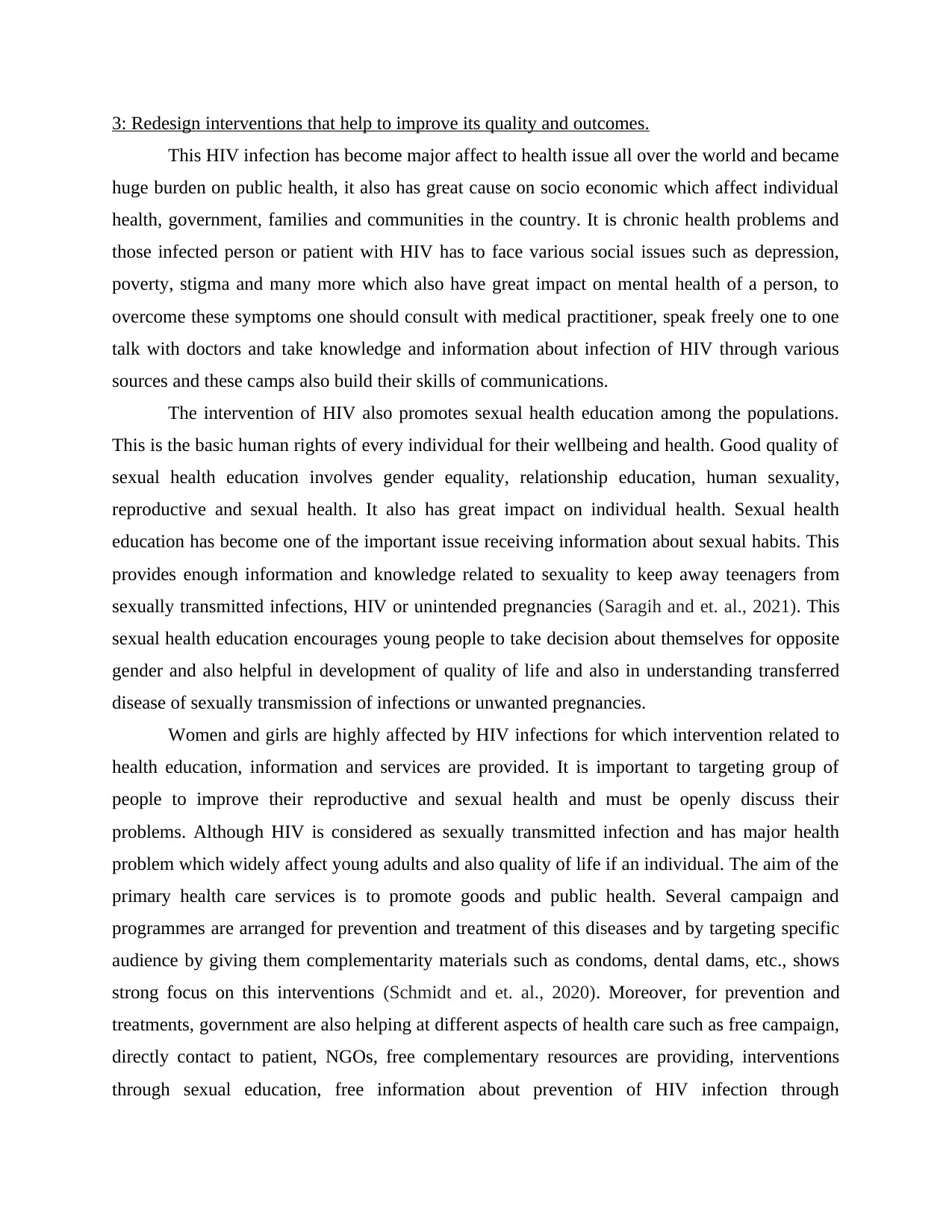
3: Redesign interventions that help to improve its quality and outcomes.
This HIV infection has become major affect to health issue all over the world and became
huge burden on public health, it also has great cause on socio economic which affect individual
health, government, families and communities in the country. It is chronic health problems and
those infected person or patient with HIV has to face various social issues such as depression,
poverty, stigma and many more which also have great impact on mental health of a person, to
overcome these symptoms one should consult with medical practitioner, speak freely one to one
talk with doctors and take knowledge and information about infection of HIV through various
sources and these camps also build their skills of communications.
The intervention of HIV also promotes sexual health education among the populations.
This is the basic human rights of every individual for their wellbeing and health. Good quality of
sexual health education involves gender equality, relationship education, human sexuality,
reproductive and sexual health. It also has great impact on individual health. Sexual health
education has become one of the important issue receiving information about sexual habits. This
provides enough information and knowledge related to sexuality to keep away teenagers from
sexually transmitted infections, HIV or unintended pregnancies (Saragih and et. al., 2021). This
sexual health education encourages young people to take decision about themselves for opposite
gender and also helpful in development of quality of life and also in understanding transferred
disease of sexually transmission of infections or unwanted pregnancies.
Women and girls are highly affected by HIV infections for which intervention related to
health education, information and services are provided. It is important to targeting group of
people to improve their reproductive and sexual health and must be openly discuss their
problems. Although HIV is considered as sexually transmitted infection and has major health
problem which widely affect young adults and also quality of life if an individual. The aim of the
primary health care services is to promote goods and public health. Several campaign and
programmes are arranged for prevention and treatment of this diseases and by targeting specific
audience by giving them complementarity materials such as condoms, dental dams, etc., shows
strong focus on this interventions (Schmidt and et. al., 2020). Moreover, for prevention and
treatments, government are also helping at different aspects of health care such as free campaign,
directly contact to patient, NGOs, free complementary resources are providing, interventions
through sexual education, free information about prevention of HIV infection through
This HIV infection has become major affect to health issue all over the world and became
huge burden on public health, it also has great cause on socio economic which affect individual
health, government, families and communities in the country. It is chronic health problems and
those infected person or patient with HIV has to face various social issues such as depression,
poverty, stigma and many more which also have great impact on mental health of a person, to
overcome these symptoms one should consult with medical practitioner, speak freely one to one
talk with doctors and take knowledge and information about infection of HIV through various
sources and these camps also build their skills of communications.
The intervention of HIV also promotes sexual health education among the populations.
This is the basic human rights of every individual for their wellbeing and health. Good quality of
sexual health education involves gender equality, relationship education, human sexuality,
reproductive and sexual health. It also has great impact on individual health. Sexual health
education has become one of the important issue receiving information about sexual habits. This
provides enough information and knowledge related to sexuality to keep away teenagers from
sexually transmitted infections, HIV or unintended pregnancies (Saragih and et. al., 2021). This
sexual health education encourages young people to take decision about themselves for opposite
gender and also helpful in development of quality of life and also in understanding transferred
disease of sexually transmission of infections or unwanted pregnancies.
Women and girls are highly affected by HIV infections for which intervention related to
health education, information and services are provided. It is important to targeting group of
people to improve their reproductive and sexual health and must be openly discuss their
problems. Although HIV is considered as sexually transmitted infection and has major health
problem which widely affect young adults and also quality of life if an individual. The aim of the
primary health care services is to promote goods and public health. Several campaign and
programmes are arranged for prevention and treatment of this diseases and by targeting specific
audience by giving them complementarity materials such as condoms, dental dams, etc., shows
strong focus on this interventions (Schmidt and et. al., 2020). Moreover, for prevention and
treatments, government are also helping at different aspects of health care such as free campaign,
directly contact to patient, NGOs, free complementary resources are providing, interventions
through sexual education, free information about prevention of HIV infection through
Paraphrase This Document
Need a fresh take? Get an instant paraphrase of this document with our AI Paraphraser
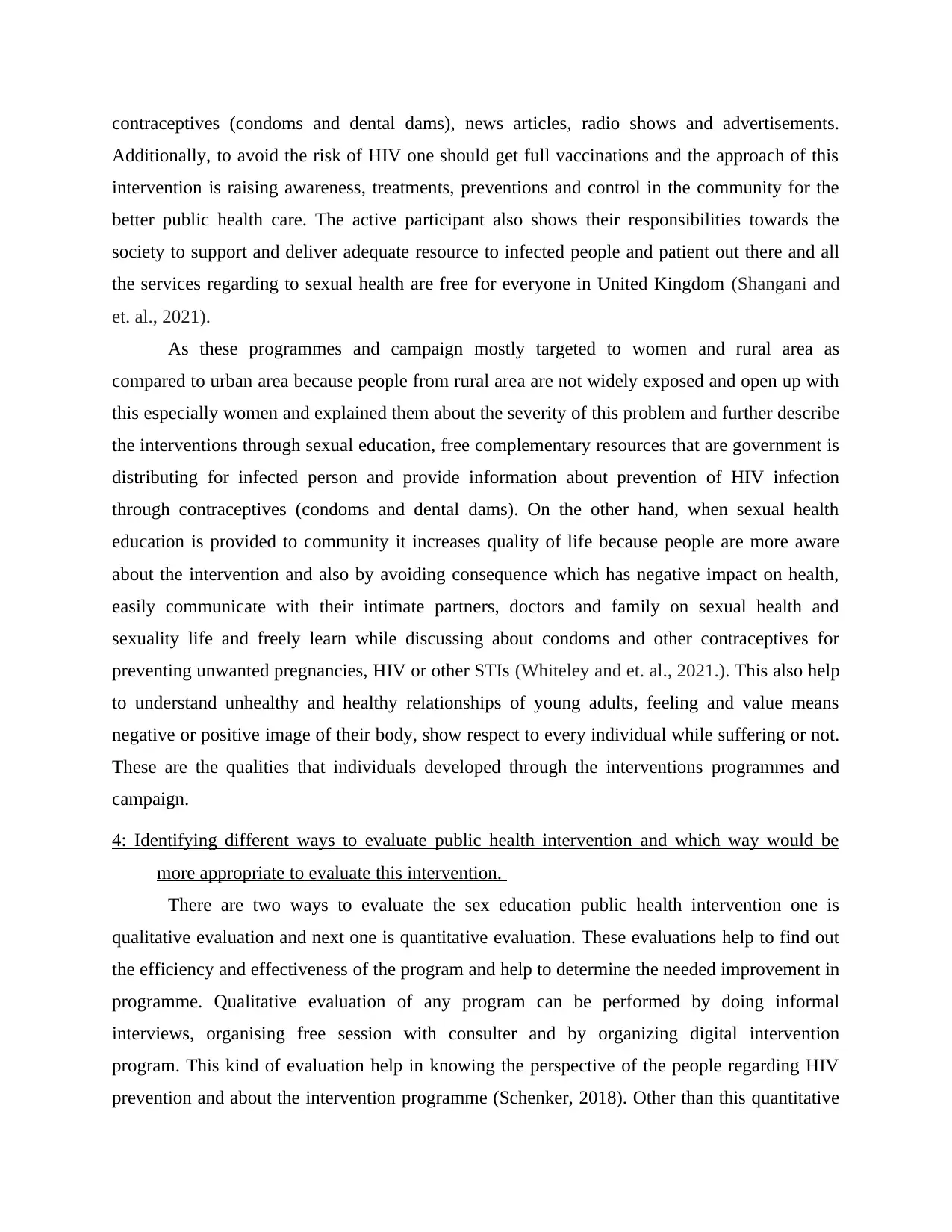
contraceptives (condoms and dental dams), news articles, radio shows and advertisements.
Additionally, to avoid the risk of HIV one should get full vaccinations and the approach of this
intervention is raising awareness, treatments, preventions and control in the community for the
better public health care. The active participant also shows their responsibilities towards the
society to support and deliver adequate resource to infected people and patient out there and all
the services regarding to sexual health are free for everyone in United Kingdom (Shangani and
et. al., 2021).
As these programmes and campaign mostly targeted to women and rural area as
compared to urban area because people from rural area are not widely exposed and open up with
this especially women and explained them about the severity of this problem and further describe
the interventions through sexual education, free complementary resources that are government is
distributing for infected person and provide information about prevention of HIV infection
through contraceptives (condoms and dental dams). On the other hand, when sexual health
education is provided to community it increases quality of life because people are more aware
about the intervention and also by avoiding consequence which has negative impact on health,
easily communicate with their intimate partners, doctors and family on sexual health and
sexuality life and freely learn while discussing about condoms and other contraceptives for
preventing unwanted pregnancies, HIV or other STIs (Whiteley and et. al., 2021.). This also help
to understand unhealthy and healthy relationships of young adults, feeling and value means
negative or positive image of their body, show respect to every individual while suffering or not.
These are the qualities that individuals developed through the interventions programmes and
campaign.
4: Identifying different ways to evaluate public health intervention and which way would be
more appropriate to evaluate this intervention.
There are two ways to evaluate the sex education public health intervention one is
qualitative evaluation and next one is quantitative evaluation. These evaluations help to find out
the efficiency and effectiveness of the program and help to determine the needed improvement in
programme. Qualitative evaluation of any program can be performed by doing informal
interviews, organising free session with consulter and by organizing digital intervention
program. This kind of evaluation help in knowing the perspective of the people regarding HIV
prevention and about the intervention programme (Schenker, 2018). Other than this quantitative
Additionally, to avoid the risk of HIV one should get full vaccinations and the approach of this
intervention is raising awareness, treatments, preventions and control in the community for the
better public health care. The active participant also shows their responsibilities towards the
society to support and deliver adequate resource to infected people and patient out there and all
the services regarding to sexual health are free for everyone in United Kingdom (Shangani and
et. al., 2021).
As these programmes and campaign mostly targeted to women and rural area as
compared to urban area because people from rural area are not widely exposed and open up with
this especially women and explained them about the severity of this problem and further describe
the interventions through sexual education, free complementary resources that are government is
distributing for infected person and provide information about prevention of HIV infection
through contraceptives (condoms and dental dams). On the other hand, when sexual health
education is provided to community it increases quality of life because people are more aware
about the intervention and also by avoiding consequence which has negative impact on health,
easily communicate with their intimate partners, doctors and family on sexual health and
sexuality life and freely learn while discussing about condoms and other contraceptives for
preventing unwanted pregnancies, HIV or other STIs (Whiteley and et. al., 2021.). This also help
to understand unhealthy and healthy relationships of young adults, feeling and value means
negative or positive image of their body, show respect to every individual while suffering or not.
These are the qualities that individuals developed through the interventions programmes and
campaign.
4: Identifying different ways to evaluate public health intervention and which way would be
more appropriate to evaluate this intervention.
There are two ways to evaluate the sex education public health intervention one is
qualitative evaluation and next one is quantitative evaluation. These evaluations help to find out
the efficiency and effectiveness of the program and help to determine the needed improvement in
programme. Qualitative evaluation of any program can be performed by doing informal
interviews, organising free session with consulter and by organizing digital intervention
program. This kind of evaluation help in knowing the perspective of the people regarding HIV
prevention and about the intervention programme (Schenker, 2018). Other than this quantitative
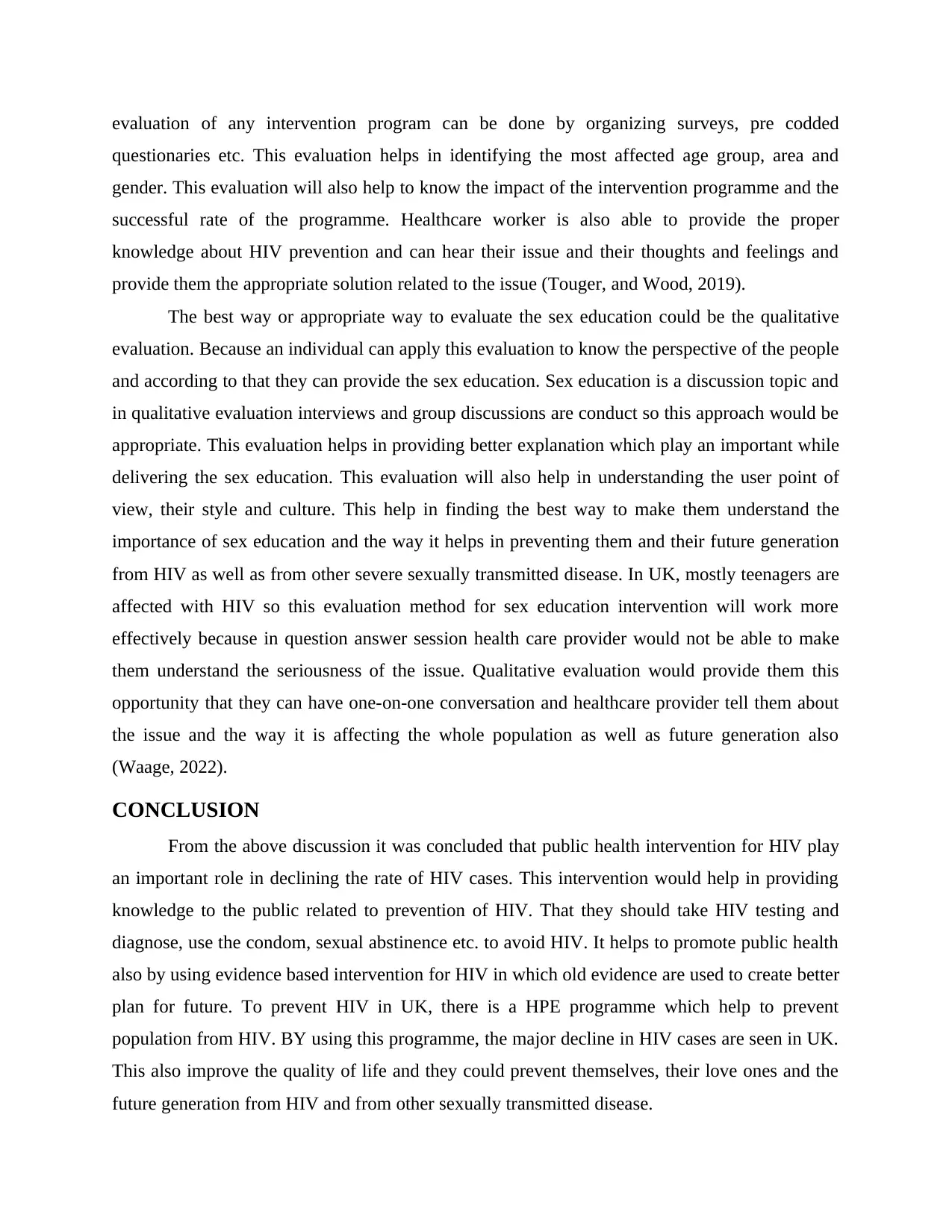
evaluation of any intervention program can be done by organizing surveys, pre codded
questionaries etc. This evaluation helps in identifying the most affected age group, area and
gender. This evaluation will also help to know the impact of the intervention programme and the
successful rate of the programme. Healthcare worker is also able to provide the proper
knowledge about HIV prevention and can hear their issue and their thoughts and feelings and
provide them the appropriate solution related to the issue (Touger, and Wood, 2019).
The best way or appropriate way to evaluate the sex education could be the qualitative
evaluation. Because an individual can apply this evaluation to know the perspective of the people
and according to that they can provide the sex education. Sex education is a discussion topic and
in qualitative evaluation interviews and group discussions are conduct so this approach would be
appropriate. This evaluation helps in providing better explanation which play an important while
delivering the sex education. This evaluation will also help in understanding the user point of
view, their style and culture. This help in finding the best way to make them understand the
importance of sex education and the way it helps in preventing them and their future generation
from HIV as well as from other severe sexually transmitted disease. In UK, mostly teenagers are
affected with HIV so this evaluation method for sex education intervention will work more
effectively because in question answer session health care provider would not be able to make
them understand the seriousness of the issue. Qualitative evaluation would provide them this
opportunity that they can have one-on-one conversation and healthcare provider tell them about
the issue and the way it is affecting the whole population as well as future generation also
(Waage, 2022).
CONCLUSION
From the above discussion it was concluded that public health intervention for HIV play
an important role in declining the rate of HIV cases. This intervention would help in providing
knowledge to the public related to prevention of HIV. That they should take HIV testing and
diagnose, use the condom, sexual abstinence etc. to avoid HIV. It helps to promote public health
also by using evidence based intervention for HIV in which old evidence are used to create better
plan for future. To prevent HIV in UK, there is a HPE programme which help to prevent
population from HIV. BY using this programme, the major decline in HIV cases are seen in UK.
This also improve the quality of life and they could prevent themselves, their love ones and the
future generation from HIV and from other sexually transmitted disease.
questionaries etc. This evaluation helps in identifying the most affected age group, area and
gender. This evaluation will also help to know the impact of the intervention programme and the
successful rate of the programme. Healthcare worker is also able to provide the proper
knowledge about HIV prevention and can hear their issue and their thoughts and feelings and
provide them the appropriate solution related to the issue (Touger, and Wood, 2019).
The best way or appropriate way to evaluate the sex education could be the qualitative
evaluation. Because an individual can apply this evaluation to know the perspective of the people
and according to that they can provide the sex education. Sex education is a discussion topic and
in qualitative evaluation interviews and group discussions are conduct so this approach would be
appropriate. This evaluation helps in providing better explanation which play an important while
delivering the sex education. This evaluation will also help in understanding the user point of
view, their style and culture. This help in finding the best way to make them understand the
importance of sex education and the way it helps in preventing them and their future generation
from HIV as well as from other severe sexually transmitted disease. In UK, mostly teenagers are
affected with HIV so this evaluation method for sex education intervention will work more
effectively because in question answer session health care provider would not be able to make
them understand the seriousness of the issue. Qualitative evaluation would provide them this
opportunity that they can have one-on-one conversation and healthcare provider tell them about
the issue and the way it is affecting the whole population as well as future generation also
(Waage, 2022).
CONCLUSION
From the above discussion it was concluded that public health intervention for HIV play
an important role in declining the rate of HIV cases. This intervention would help in providing
knowledge to the public related to prevention of HIV. That they should take HIV testing and
diagnose, use the condom, sexual abstinence etc. to avoid HIV. It helps to promote public health
also by using evidence based intervention for HIV in which old evidence are used to create better
plan for future. To prevent HIV in UK, there is a HPE programme which help to prevent
population from HIV. BY using this programme, the major decline in HIV cases are seen in UK.
This also improve the quality of life and they could prevent themselves, their love ones and the
future generation from HIV and from other sexually transmitted disease.
⊘ This is a preview!⊘
Do you want full access?
Subscribe today to unlock all pages.

Trusted by 1+ million students worldwide
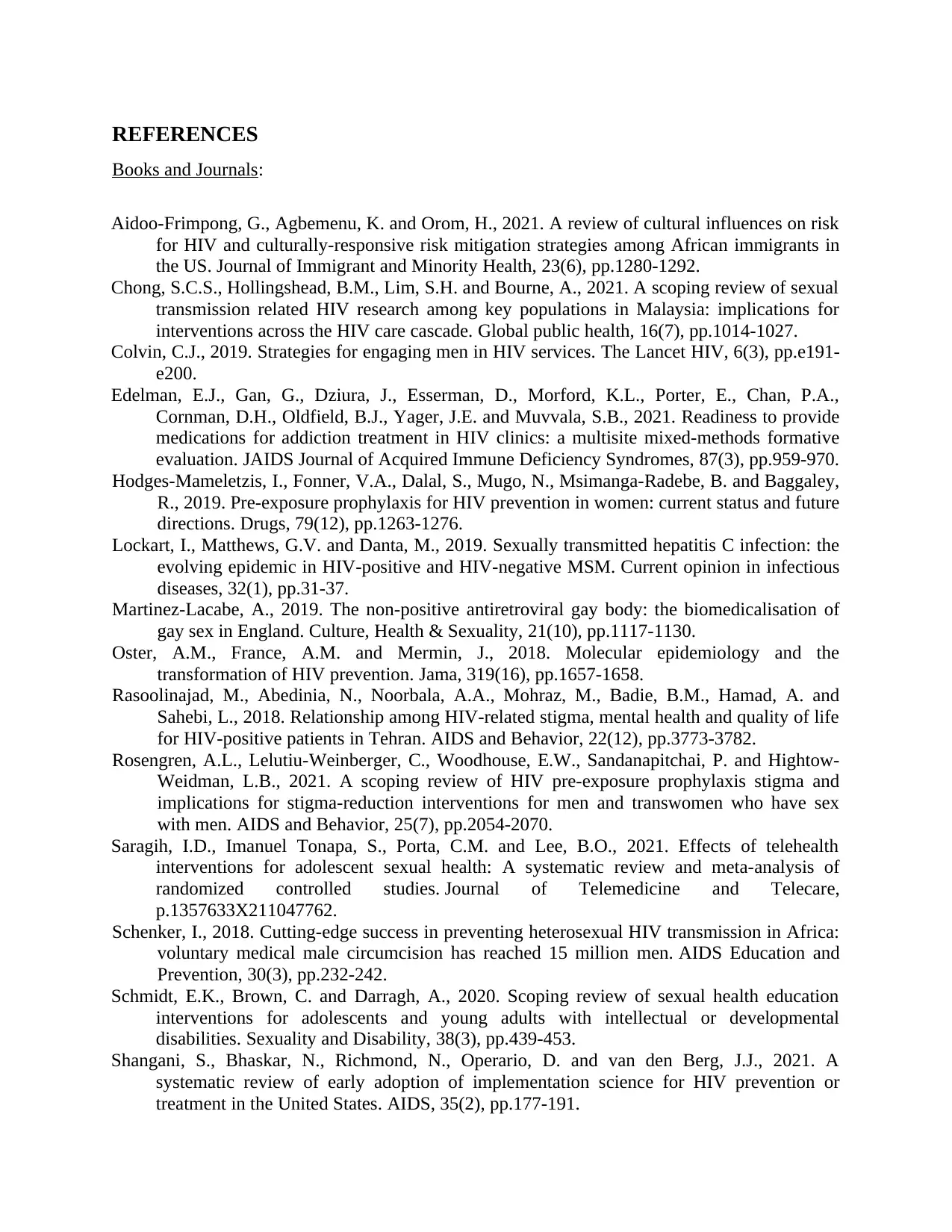
REFERENCES
Books and Journals:
Aidoo-Frimpong, G., Agbemenu, K. and Orom, H., 2021. A review of cultural influences on risk
for HIV and culturally-responsive risk mitigation strategies among African immigrants in
the US. Journal of Immigrant and Minority Health, 23(6), pp.1280-1292.
Chong, S.C.S., Hollingshead, B.M., Lim, S.H. and Bourne, A., 2021. A scoping review of sexual
transmission related HIV research among key populations in Malaysia: implications for
interventions across the HIV care cascade. Global public health, 16(7), pp.1014-1027.
Colvin, C.J., 2019. Strategies for engaging men in HIV services. The Lancet HIV, 6(3), pp.e191-
e200.
Edelman, E.J., Gan, G., Dziura, J., Esserman, D., Morford, K.L., Porter, E., Chan, P.A.,
Cornman, D.H., Oldfield, B.J., Yager, J.E. and Muvvala, S.B., 2021. Readiness to provide
medications for addiction treatment in HIV clinics: a multisite mixed-methods formative
evaluation. JAIDS Journal of Acquired Immune Deficiency Syndromes, 87(3), pp.959-970.
Hodges-Mameletzis, I., Fonner, V.A., Dalal, S., Mugo, N., Msimanga-Radebe, B. and Baggaley,
R., 2019. Pre-exposure prophylaxis for HIV prevention in women: current status and future
directions. Drugs, 79(12), pp.1263-1276.
Lockart, I., Matthews, G.V. and Danta, M., 2019. Sexually transmitted hepatitis C infection: the
evolving epidemic in HIV-positive and HIV-negative MSM. Current opinion in infectious
diseases, 32(1), pp.31-37.
Martinez-Lacabe, A., 2019. The non-positive antiretroviral gay body: the biomedicalisation of
gay sex in England. Culture, Health & Sexuality, 21(10), pp.1117-1130.
Oster, A.M., France, A.M. and Mermin, J., 2018. Molecular epidemiology and the
transformation of HIV prevention. Jama, 319(16), pp.1657-1658.
Rasoolinajad, M., Abedinia, N., Noorbala, A.A., Mohraz, M., Badie, B.M., Hamad, A. and
Sahebi, L., 2018. Relationship among HIV-related stigma, mental health and quality of life
for HIV-positive patients in Tehran. AIDS and Behavior, 22(12), pp.3773-3782.
Rosengren, A.L., Lelutiu-Weinberger, C., Woodhouse, E.W., Sandanapitchai, P. and Hightow-
Weidman, L.B., 2021. A scoping review of HIV pre-exposure prophylaxis stigma and
implications for stigma-reduction interventions for men and transwomen who have sex
with men. AIDS and Behavior, 25(7), pp.2054-2070.
Saragih, I.D., Imanuel Tonapa, S., Porta, C.M. and Lee, B.O., 2021. Effects of telehealth
interventions for adolescent sexual health: A systematic review and meta-analysis of
randomized controlled studies. Journal of Telemedicine and Telecare,
p.1357633X211047762.
Schenker, I., 2018. Cutting-edge success in preventing heterosexual HIV transmission in Africa:
voluntary medical male circumcision has reached 15 million men. AIDS Education and
Prevention, 30(3), pp.232-242.
Schmidt, E.K., Brown, C. and Darragh, A., 2020. Scoping review of sexual health education
interventions for adolescents and young adults with intellectual or developmental
disabilities. Sexuality and Disability, 38(3), pp.439-453.
Shangani, S., Bhaskar, N., Richmond, N., Operario, D. and van den Berg, J.J., 2021. A
systematic review of early adoption of implementation science for HIV prevention or
treatment in the United States. AIDS, 35(2), pp.177-191.
Books and Journals:
Aidoo-Frimpong, G., Agbemenu, K. and Orom, H., 2021. A review of cultural influences on risk
for HIV and culturally-responsive risk mitigation strategies among African immigrants in
the US. Journal of Immigrant and Minority Health, 23(6), pp.1280-1292.
Chong, S.C.S., Hollingshead, B.M., Lim, S.H. and Bourne, A., 2021. A scoping review of sexual
transmission related HIV research among key populations in Malaysia: implications for
interventions across the HIV care cascade. Global public health, 16(7), pp.1014-1027.
Colvin, C.J., 2019. Strategies for engaging men in HIV services. The Lancet HIV, 6(3), pp.e191-
e200.
Edelman, E.J., Gan, G., Dziura, J., Esserman, D., Morford, K.L., Porter, E., Chan, P.A.,
Cornman, D.H., Oldfield, B.J., Yager, J.E. and Muvvala, S.B., 2021. Readiness to provide
medications for addiction treatment in HIV clinics: a multisite mixed-methods formative
evaluation. JAIDS Journal of Acquired Immune Deficiency Syndromes, 87(3), pp.959-970.
Hodges-Mameletzis, I., Fonner, V.A., Dalal, S., Mugo, N., Msimanga-Radebe, B. and Baggaley,
R., 2019. Pre-exposure prophylaxis for HIV prevention in women: current status and future
directions. Drugs, 79(12), pp.1263-1276.
Lockart, I., Matthews, G.V. and Danta, M., 2019. Sexually transmitted hepatitis C infection: the
evolving epidemic in HIV-positive and HIV-negative MSM. Current opinion in infectious
diseases, 32(1), pp.31-37.
Martinez-Lacabe, A., 2019. The non-positive antiretroviral gay body: the biomedicalisation of
gay sex in England. Culture, Health & Sexuality, 21(10), pp.1117-1130.
Oster, A.M., France, A.M. and Mermin, J., 2018. Molecular epidemiology and the
transformation of HIV prevention. Jama, 319(16), pp.1657-1658.
Rasoolinajad, M., Abedinia, N., Noorbala, A.A., Mohraz, M., Badie, B.M., Hamad, A. and
Sahebi, L., 2018. Relationship among HIV-related stigma, mental health and quality of life
for HIV-positive patients in Tehran. AIDS and Behavior, 22(12), pp.3773-3782.
Rosengren, A.L., Lelutiu-Weinberger, C., Woodhouse, E.W., Sandanapitchai, P. and Hightow-
Weidman, L.B., 2021. A scoping review of HIV pre-exposure prophylaxis stigma and
implications for stigma-reduction interventions for men and transwomen who have sex
with men. AIDS and Behavior, 25(7), pp.2054-2070.
Saragih, I.D., Imanuel Tonapa, S., Porta, C.M. and Lee, B.O., 2021. Effects of telehealth
interventions for adolescent sexual health: A systematic review and meta-analysis of
randomized controlled studies. Journal of Telemedicine and Telecare,
p.1357633X211047762.
Schenker, I., 2018. Cutting-edge success in preventing heterosexual HIV transmission in Africa:
voluntary medical male circumcision has reached 15 million men. AIDS Education and
Prevention, 30(3), pp.232-242.
Schmidt, E.K., Brown, C. and Darragh, A., 2020. Scoping review of sexual health education
interventions for adolescents and young adults with intellectual or developmental
disabilities. Sexuality and Disability, 38(3), pp.439-453.
Shangani, S., Bhaskar, N., Richmond, N., Operario, D. and van den Berg, J.J., 2021. A
systematic review of early adoption of implementation science for HIV prevention or
treatment in the United States. AIDS, 35(2), pp.177-191.
Paraphrase This Document
Need a fresh take? Get an instant paraphrase of this document with our AI Paraphraser

Touger, R. and Wood, B.R., 2019. A review of telehealth innovations for HIV pre-exposure
prophylaxis (PrEP). Current HIV/AIDS Reports, 16(1), pp.113-119.
Waage, M., 2022. Self-Management Interventions for HIV and NCDs in Sub-Saharan Africa: A
Scoping Review of Literature.
Whiteley, L.B., Olsen, E.M., Haubrick, K.K., Odoom, E., Tarantino, N. and Brown, L.K., 2021.
A review of interventions to enhance HIV medication adherence. Current HIV/AIDS
Reports, 18(5), pp.443-457.
prophylaxis (PrEP). Current HIV/AIDS Reports, 16(1), pp.113-119.
Waage, M., 2022. Self-Management Interventions for HIV and NCDs in Sub-Saharan Africa: A
Scoping Review of Literature.
Whiteley, L.B., Olsen, E.M., Haubrick, K.K., Odoom, E., Tarantino, N. and Brown, L.K., 2021.
A review of interventions to enhance HIV medication adherence. Current HIV/AIDS
Reports, 18(5), pp.443-457.
1 out of 11
Related Documents
Your All-in-One AI-Powered Toolkit for Academic Success.
+13062052269
info@desklib.com
Available 24*7 on WhatsApp / Email
![[object Object]](/_next/static/media/star-bottom.7253800d.svg)
Unlock your academic potential
Copyright © 2020–2025 A2Z Services. All Rights Reserved. Developed and managed by ZUCOL.




